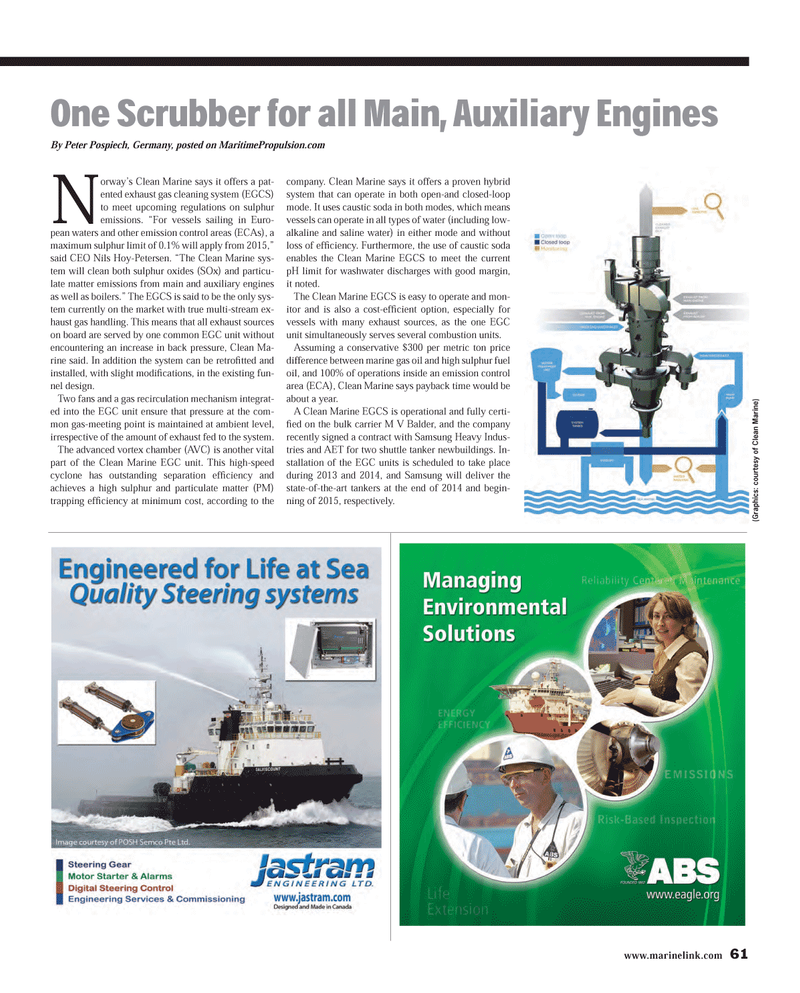
Page 61: of Maritime Reporter Magazine (August 2013)
Shipyard Edition
Read this page in Pdf, Flash or Html5 edition of August 2013 Maritime Reporter Magazine
www.marinelink.com 61Norway?s Clean Marine says it offers a pat- ented exhaust gas cleaning system (EGCS) to meet upcoming regulations on sulphur emissions. ?For vessels sailing in Euro-pean waters and other emission control areas (ECAs), a maximum sulphur limit of 0.1% will apply from 2015,? said CEO Nils Hoy-Petersen. ?The Clean Marine sys-tem will clean both sulphur oxides (SOx) and particu-late matter emissions from main and auxiliary engines as well as boilers.? The EGCS is said to be the only sys- tem currently on the market with true multi-stream ex-haust gas handling. This means that all exhaust sources on board are served by one common EGC unit without encountering an increase in back pressure, Clean Ma-rine said. In addition the system can be retroÞ tted and installed, with slight modiÞ cations, in the existing fun- nel design. Two fans and a gas recirculation mechanism integrat- ed into the EGC unit ensure that pressure at the com-mon gas-meeting point is maintained at ambient level, irrespective of the amount of exhaust fed to the system.The advanced vortex chamber (AVC) is another vital part of the Clean Marine EGC unit. This high-speed cyclone has outstanding separation efÞ ciency and achieves a high sulphur and particulate matter (PM) trapping efÞ ciency at minimum cost, according to the company. Clean Marine says it offers a proven hybrid system that can operate in both open-and closed-loop mode. It uses caustic soda in both modes, which means vessels can operate in all types of water (including low-alkaline and saline water) in either mode and without loss of efÞ ciency. Furthermore, the use of caustic soda enables the Clean Marine EGCS to meet the current pH limit for washwater discharges with good margin, it noted.The Clean Marine EGCS is easy to operate and mon-itor and is also a cost-efÞ cient option, especially for vessels with many exhaust sources, as the one EGC unit simultaneously serves several combustion units.Assuming a conservative $300 per metric ton price difference between marine gas oil and high sulphur fuel oil, and 100% of operations inside an emission control area (ECA), Clean Marine says payback time would be about a year. A Clean Marine EGCS is operational and fully certi- Þ ed on the bulk carrier M V Balder, and the company recently signed a contract with Samsung Heavy Indus-tries and AET for two shuttle tanker newbuildings. In- stallation of the EGC units is scheduled to take place during 2013 and 2014, and Samsung will deliver the state-of-the-art tankers at the end of 2014 and begin-ning of 2015, respectively. One Scrubber for all Main, Auxiliary Engines By Peter Pospiech, Germany, posted on MaritimePropulsion.com (Graphics: courtesy of Clean Marine) MR #8 (58-65).indd 61MR #8 (58-65).indd 618/1/2013 2:49:46 PM8/1/2013 2:49:46 PM

 60
60

 62
62
